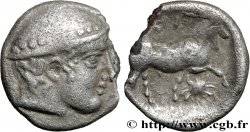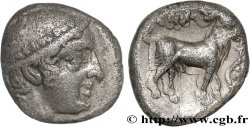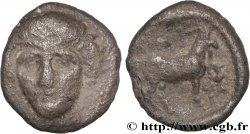v51_0049 - THRACE - AINOS Diobole
MONNAIES 51 (2011)
Starting price : 650.00 €
Estimate : 950.00 €
Realised price : 840.00 €
Number of bids : 3
Maximum bid : 1 700.00 €
Starting price : 650.00 €
Estimate : 950.00 €
Realised price : 840.00 €
Number of bids : 3
Maximum bid : 1 700.00 €
Type : Diobole
Date: c. 427/426 - 425/424 AC.
Mint name / Town : Thrace, Aenos (Ainos)
Metal : silver
Diameter : 12 mm
Orientation dies : 3 h.
Weight : 1,37 g.
Rarity : R2
Coments on the condition:
Exemplaire sur un flan large, bien centré des deux côtés. Très belle tête d’Hermès, bien venue à la frappe et de haut relief. Joli revers de style fin, bien détaillé. Belle collection de collection ancienne avec des reflets dorés
Catalogue references :
Predigree :
Cet exemplaire provient du stock de Richelieu Numismatique, janvier 1997
Obverse
Obverse legend : ANÉPIGRAPHE.
Obverse description : Tête d'Hermès à droite, coiffée du pétase sans bord, orné d'un grènetis, les cheveux flottant en mèches courtes.
Reverse
Reverse description : Bouc paissant à droite, la tête légèrement courbée ; devant un chardon.
Reverse legend : AINI
Reverse translation : (d’Aenos).
Commentary
Trace de cassure de coin perceptible au droit sur le pétase d’Hermès, le grènetis composé de douze perles. Légère trace de tréflage dans la légende. Le plant qu’ingurgite le bouc est finement détaillé. Notre exemplaire est très proche de ceux de la collection Pozzi (n° 1034 et 1035, pl. XXXIV). Semble de même coin que l’exemplaire du Danish National Museum (SNG. Cop. n° 402, pl. 8).
Trace of die breakage visible on the obverse of the Hermes petasus, the beading composed of twelve pearls. Slight trace of plaiting in the legend. The plant that the goat ingests is finely detailed. Our example is very close to those in the Pozzi collection (nos. 1034 and 1035, pl. XXXIV). Seems to be of the same die as the example in the Danish National Museum (SNG. Cop. no. 402, pl. 8)
Trace of die breakage visible on the obverse of the Hermes petasus, the beading composed of twelve pearls. Slight trace of plaiting in the legend. The plant that the goat ingests is finely detailed. Our example is very close to those in the Pozzi collection (nos. 1034 and 1035, pl. XXXIV). Seems to be of the same die as the example in the Danish National Museum (SNG. Cop. no. 402, pl. 8)








 Report a mistake
Report a mistake Print the page
Print the page Share my selection
Share my selection Ask a question
Ask a question Consign / sell
Consign / sell
 Full data
Full data










